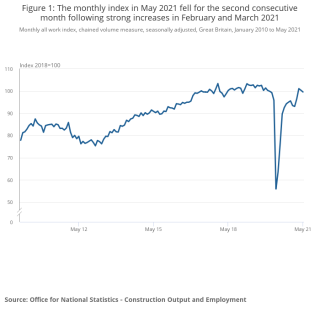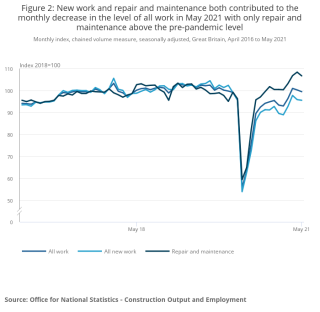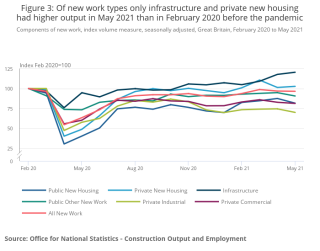Latest data from the Office for National Statistics (ONS) show that construction output in Great Britain fell 0.8% in May 2021, following a 0.7% decline in April.
Anecdotal evidence from businesses suggests that adverse weather conditions were a contributing factor, ONS said. It was the fourth wettest May on record since 1862, according to the Met Office.
However, others suggest that shortages of materials might have inhibited construction activity more than a bit of rain.
Monthly construction fell by 0.8% in May 2021 from a month earlier because of declines in both new work (0.4%) and repair and maintenance (1.5%).
However, monthly construction output of £13,960m in May remains 0.3% (£43m) above the pre-pandemic February 2020 level. While new work was 3.5% (£320m) below the February 2020 level, repair & maintenance work was 7.5% (£363m) above the February 2020 level.
In contrast to the monthly fall, construction output grew by 6.3% in the three months to May 2021 compared with the previous three-month period, with increases in both new work and repair & maintenance of 6.6% and 5.8% respectively.
The increase in new work (6.6%) in the three months May 2021 was because of growth seen in all sectors, the largest contributors to this growth were private housing new work and infrastructure, which grew by 7.4% and 9.7% respectively.
The increase in repair & maintenance (5.8%) in the three months to May 2021 was because of growth in non-housing and private housing repair and maintenance, which grew by 9.0% and 4.7% respectively.

Industry comment
Mark Robinson, chief executive of procurement business Scape, suggested that slow-down was due to shortages, not the rain. He said: “The shortage of materials and skilled workers is clearly beginning to take its toll, reducing the sector’s resilience and risking its capacity to keep pace with the growing demand created by the economic recovery. It’s more important than ever that we work together to prevent project budgets and timescales from spiralling and the industry’s revival from faltering.
“Sustained investment will be key if these challenges are to be overcome. Expanding the trades which are on the government’s shortage occupation list will be a strong first step to easing the pressure. But attracting and training the talent of tomorrow is ultimately the best long-term solution, ensuring that both the sector and the economy bounce back fully.”
Clive Docwra, managing director of construction consultant McBains, said: “Given today’s figures show the second successive monthly fall in output after several months of steady growth, it shows just how fragile recovery remains in the construction sector.
“Adverse weather conditions during May undoubtedly contributed to this fall, but the fact that order books dried up is worrying for the industry, with new work contracts 3.5% down on pre-pandemic levels.
“On the plus side, the three months to May figures are more encouraging but to maintain this longer-term trend month-on-month growth will need to pick up again next month.
“In addition, a continued shortage of materials – in particular cement, electrical components, timber and steel – is in turn fuelling price rises for construction firms and increasing the risk of wider inflationary pressures.
“With commercial construction work expected to continue to pick up as offices return over the next few months, this materials shortage could also mean a bottleneck in the supply chain that means more projects may be put on hold, putting any revival at risk.”
Brian Berry, chief executive of the Federation of Master Builders, said: “I am particularly concerned by the drop in repair, maintenance and improvement activities, given the high demand for home improvement works that builders are reporting. Action must taken to address the national building materials shortage, as this is restricting builders' ability to build back better and greener. A recent FMB survey found that 93% of builders reported material price increases in Q1 2021, which is an untenable situation. Manufacturers, merchants and builders must work together to maintain the supply of products to independent merchants so that smaller builders can continue to improve, upgrade and green the nation’s homes.”
Got a story? Email news@theconstructionindex.co.uk
.png)





